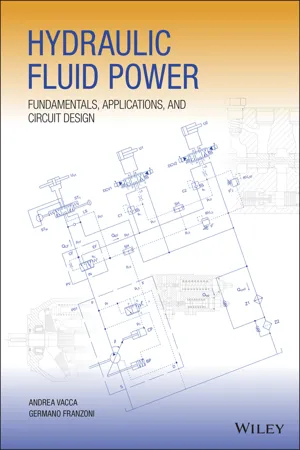
Hydraulic Fluid Power
Fundamentals, Applications, and Circuit Design
- English
- ePUB (mobile friendly)
- Available on iOS & Android
Hydraulic Fluid Power
Fundamentals, Applications, and Circuit Design
About this book
LEARN MORE ABOUT HYDRAULIC TECHNOLOGY IN HYDRAULIC SYSTEMS DESIGN WITH THIS COMPREHENSIVE RESOURCE
Hydraulic Fluid Power provides readers with an original approach to hydraulic technology education that focuses on the design of complete hydraulic systems. Accomplished authors and researchers Andrea Vacca and Germano Franzoni begin by describing the foundational principles of hydraulics and the basic physical components of hydraulics systems. They go on to walk readers through the most practical and useful system concepts for controlling hydraulic functions in modern, state-of-the-art systems.
Written in an approachable and accessible style, the book's concepts are classified, analyzed, presented, and compared on a system level. The book also provides readers with the basic and advanced tools required to understand how hydraulic circuit design affects the operation of the equipment in which it's found, focusing on the energy performance and control features of each design architecture. Readers will also learn how to choose the best design solution for any application.
Readers of Hydraulic Fluid Power will benefit from:
- Approaching hydraulic fluid power concepts from an "outside-in" perspective, emphasizing a problem-solving orientation
- Abundant numerical examples and end-of-chapter problems designed to aid the reader in learning and retaining the material
- A balance between academic and practical content derived from the authors' experience in both academia and industry
- Strong coverage of the fundamentals of hydraulic systems, including the equations and properties of hydraulic fluids
Hydraulic Fluid Power is perfect for undergraduate and graduate students of mechanical, agricultural, and aerospace engineering, as well as engineers designing hydraulic components, mobile machineries, or industrial systems.
Frequently asked questions
- Essential is ideal for learners and professionals who enjoy exploring a wide range of subjects. Access the Essential Library with 800,000+ trusted titles and best-sellers across business, personal growth, and the humanities. Includes unlimited reading time and Standard Read Aloud voice.
- Complete: Perfect for advanced learners and researchers needing full, unrestricted access. Unlock 1.4M+ books across hundreds of subjects, including academic and specialized titles. The Complete Plan also includes advanced features like Premium Read Aloud and Research Assistant.
Please note we cannot support devices running on iOS 13 and Android 7 or earlier. Learn more about using the app.
Information
Part I
Fundamental Principles
Objectives
- Interpret circuits drawn with symbols of the ISO standard of representation.
- Discuss the most common hydraulic fluids and describe the most important fluid properties affecting the operation of a hydraulic system.
- Describe the concept of fluid cavitation or aeration and determine the effect on the fluid properties.
- Describe the detrimental effects of solid contaminants in a hydraulic system.
- Identify sources of energy loss, as turbulent or laminar hydraulic resistance.
- Analyze flow forces in hydraulic components resulting from variation of fluid momentum.
- Analyze the steady‐state operation of a flow network, based on the pressure law and flow law.
- Derive the orifice equation starting from the fundamental Bernoulli equation.
- Recognize the function of a specific orifice in a hydraulic network.
- Discuss the concept of hydraulic resistance,...
Table of contents
- Cover
- Table of Contents
- Title Page
- Copyright
- Preface
- Acknowledgments
- Part I: Fundamental Principles
- Part II: Hydraulic Components
- Part III: Actuator Control Concepts
- Part IV: Metering Controls for a Single Actuator
- Part V: Metering Controls for Multiple Actuators
- Part VI: Hydrostatic Transmissions and Hydrostatic Actuators
- Appendix A: Prime Movers and Their Interaction with the Hydraulic Circuit
- Index
- End User License Agreement